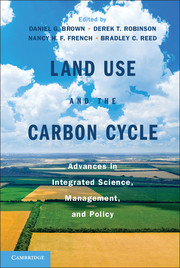Book contents
- Frontmatter
- Contents
- Chapter Authors and Affiliations
- Acknowledgments
- Acronyms
- Part I Introduction
- 1 Linking Land Use and the Carbon Cycle
- 2 An Introduction to Carbon Cycle Science
- 3 The Contribution of Land Use and Land-Use Change to the Carbon Cycle
- 4 An Economic Analysis of the Effect of Land Use on Terrestrial Carbon Storage
- Part II Measurement and Modeling
- Part III Integrated Science and Research Applications
- Part IV Land Policy, Management, and the Carbon Cycle
- Part V Synthesis and Future Directions
- Index
- Plate Section
- References
2 - An Introduction to Carbon Cycle Science
Published online by Cambridge University Press: 05 February 2013
- Frontmatter
- Contents
- Chapter Authors and Affiliations
- Acknowledgments
- Acronyms
- Part I Introduction
- 1 Linking Land Use and the Carbon Cycle
- 2 An Introduction to Carbon Cycle Science
- 3 The Contribution of Land Use and Land-Use Change to the Carbon Cycle
- 4 An Economic Analysis of the Effect of Land Use on Terrestrial Carbon Storage
- Part II Measurement and Modeling
- Part III Integrated Science and Research Applications
- Part IV Land Policy, Management, and the Carbon Cycle
- Part V Synthesis and Future Directions
- Index
- Plate Section
- References
Summary
Introduction
The carbon (C) cycle is central to processes that provide food, fiber, and fuel for all of the Earth's inhabitants. From the air we breathe to the soils we farm and the food we eat, we are inescapably intertwined with the C cycle. Contributions of terrestrial ecosystems to the global C cycle are key, and the link to land change is important to understand. In this chapter, the mechanisms of the C cycle are described in Section 2 along with the historical and current trends of carbon dioxide (CO2) storage and fluxes, as well as how those fluxes interact with climate. Methods to measure and monitor the various components of the C cycle are discussed in Section 3. The chapter covers all aspects of the C cycle with an emphasis on terrestrial C and a review of how different land-cover types (e.g., forest, grasslands, and crops) affect the C cycle (Section 4). A review of how the C cycle connects to other biogeochemical cycles under the influence of land change is presented in Section 5. Despite a fairly comprehensive understanding of the global C cycle derived from the recent increase in C cycle research, current gaps exist in our knowledge related to the magnitude of the influence of land use on C, as discussed in Section 6. For a comprehensive review of the C cycle, the reader is referred to Field and Raupach (2004).
Role of the Carbon Cycle in Earth's Evolution
CO2in the atmosphere is critical for life on Earth in two ways. First, CO2 is the second most abundant greenhouse gas (GHG) in the atmosphere after water vapor. Without GHGs, the mean temperature at the Earth's surface would be about 33ºC lower than it is today and would probably be unable to support life. Second, photosynthetic organisms use CO2 in the presence of light to produce organic matter that eventually becomes the basic food source for all microbes, animals, and humans.
Information
- Type
- Chapter
- Information
- Land Use and the Carbon CycleAdvances in Integrated Science, Management, and Policy, pp. 24 - 51Publisher: Cambridge University PressPrint publication year: 2013
References
Accessibility standard: Unknown
Why this information is here
This section outlines the accessibility features of this content - including support for screen readers, full keyboard navigation and high-contrast display options. This may not be relevant for you.Accessibility Information
- 3
- Cited by
